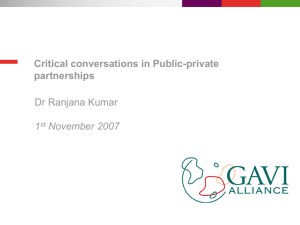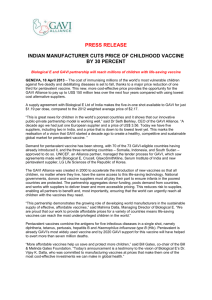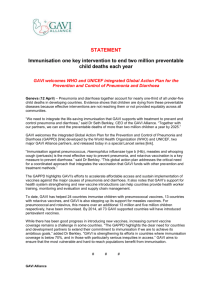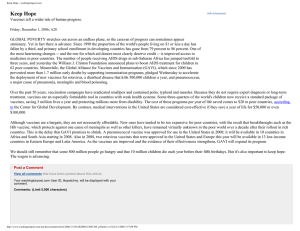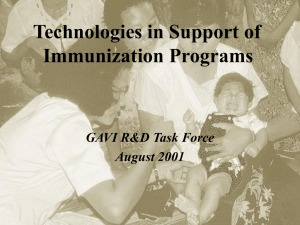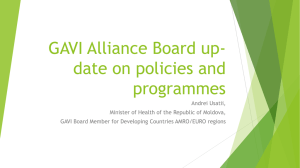GAVI’S FUTURE
advertisement
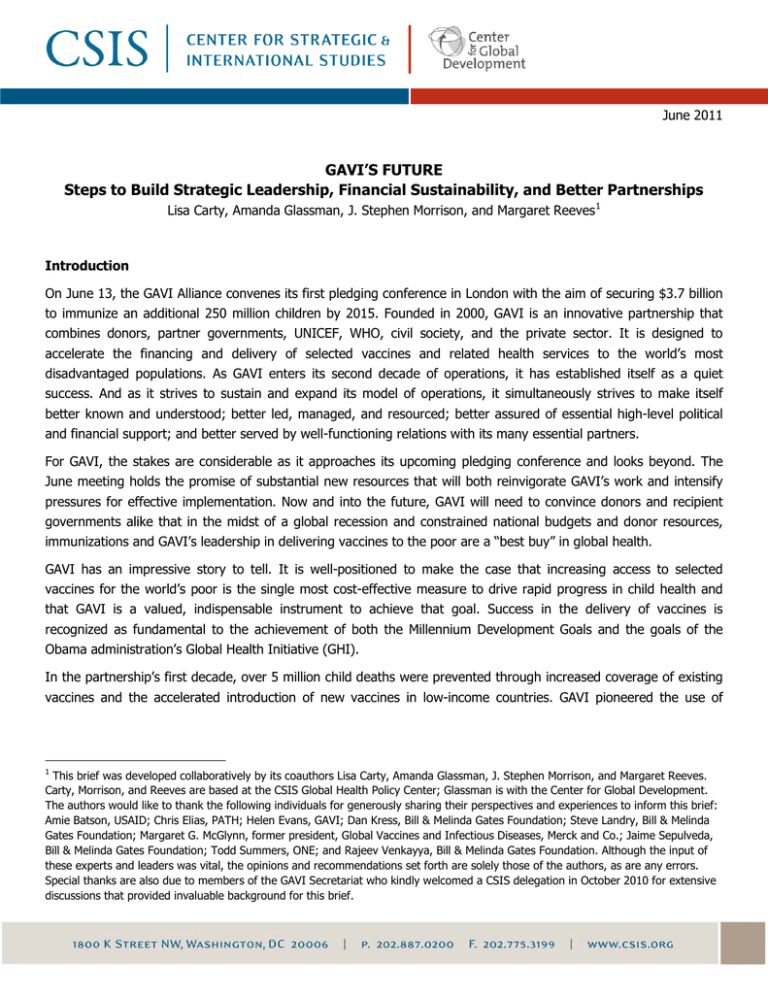
June 2011 GAVI’S FUTURE Steps to Build Strategic Leadership, Financial Sustainability, and Better Partnerships Lisa Carty, Amanda Glassman, J. Stephen Morrison, and Margaret Reeves 1 Introduction On June 13, the GAVI Alliance convenes its first pledging conference in London with the aim of securing $3.7 billion to immunize an additional 250 million children by 2015. Founded in 2000, GAVI is an innovative partnership that combines donors, partner governments, UNICEF, WHO, civil society, and the private sector. It is designed to accelerate the financing and delivery of selected vaccines and related health services to the world’s most disadvantaged populations. As GAVI enters its second decade of operations, it has established itself as a quiet success. And as it strives to sustain and expand its model of operations, it simultaneously strives to make itself better known and understood; better led, managed, and resourced; better assured of essential high-level political and financial support; and better served by well-functioning relations with its many essential partners. For GAVI, the stakes are considerable as it approaches its upcoming pledging conference and looks beyond. The June meeting holds the promise of substantial new resources that will both reinvigorate GAVI’s work and intensify pressures for effective implementation. Now and into the future, GAVI will need to convince donors and recipient governments alike that in the midst of a global recession and constrained national budgets and donor resources, immunizations and GAVI’s leadership in delivering vaccines to the poor are a “best buy” in global health. GAVI has an impressive story to tell. It is well-positioned to make the case that increasing access to selected vaccines for the world’s poor is the single most cost-effective measure to drive rapid progress in child health and that GAVI is a valued, indispensable instrument to achieve that goal. Success in the delivery of vaccines is recognized as fundamental to the achievement of both the Millennium Development Goals and the goals of the Obama administration’s Global Health Initiative (GHI). In the partnership’s first decade, over 5 million child deaths were prevented through increased coverage of existing vaccines and the accelerated introduction of new vaccines in low-income countries. GAVI pioneered the use of 1 This brief was developed collaboratively by its coauthors Lisa Carty, Amanda Glassman, J. Stephen Morrison, and Margaret Reeves. Carty, Morrison, and Reeves are based at the CSIS Global Health Policy Center; Glassman is with the Center for Global Development. The authors would like to thank the following individuals for generously sharing their perspectives and experiences to inform this brief: Amie Batson, USAID; Chris Elias, PATH; Helen Evans, GAVI; Dan Kress, Bill & Melinda Gates Foundation; Steve Landry, Bill & Melinda Gates Foundation; Margaret G. McGlynn, former president, Global Vaccines and Infectious Diseases, Merck and Co.; Jaime Sepulveda, Bill & Melinda Gates Foundation; Todd Summers, ONE; and Rajeev Venkayya, Bill & Melinda Gates Foundation. Although the input of these experts and leaders was vital, the opinions and recommendations set forth are solely those of the authors, as are any errors. Special thanks are also due to members of the GAVI Secretariat who kindly welcomed a CSIS delegation in October 2010 for extensive discussions that provided invaluable background for this brief. 2 innovative financing mechanisms, most notably the International Financing Facility for Immunization 2 and the Advanced Market Commitment, 3 and it contributed to price reductions for some vaccines. GAVI was among the first of this past decade’s new international health initiatives to require cofinancing from all participating countries, a pivotal precondition to leverage partner governments to invest politically and financially in vaccines as a national priority that will be sustained over time. GAVI was an early proponent of results-based aid, conditioning the disbursement of a portion of its Immunization Support Services (ISS) funding to measured progress in vaccination coverage. GAVI and its policy and financing instruments have been independently evaluated multiple times, and GAVI has earned generally high marks and is committed to continuing to work closely with partner countries to prioritize greater accountability and transparency in its programs. Its many achievements notwithstanding, GAVI still needs a strategic approach in the coming years if it is to deepen its impact, get the maximum returns from its implementing partners, attract expanded donor support, and leverage greater commitments from recipient partner governments. GAVI has at critical moments in recent years lacked that strategic focus. GAVI has entered into the complex area of health systems strengthening, often without clear policy parameters and at the expense of its core mission. It has struggled to ensure that countries receive the necessary technical expertise to plan for new vaccine introduction and to ensure that plans are in place for longer-term financial sustainability as GAVI’s support is phased down. Funding gaps threaten to limit the scope of future activities. Board oversight has at times been weak. Evaluation of GAVI’s ISS window suggests that higher quality, more independent results measurement and evaluation are needed to assure reliable estimates of vaccination coverage and to generate learning from innovations in vaccine delivery strategies. Despite GAVI’s often impressive results, the alliance’s message and brand identity have often been difficult to discern, muddled by several factors: that GAVI is in fact a complex alliance, and not a single bounded entity; that it is immunizations—and not GAVI—that are everyone’s top concern; that the GAVI Board comprises a contentious mix of prominent independent opinion leaders, the pharmaceutical industry, GAVI grant recipients, foundation and government donors, international organizations and civil society; and that GAVI has remained principally a finance mechanism, an operation whose visible, on-the-ground achievements are implemented by ministries of health, nongovernmental organizations, and technical partners like UNICEF, WHO, and the World Bank. At important points, there has been heated debate over whether GAVI’s focus on new and underused vaccines detracts from the critical need to maintain and in some cases expand access to basic childhood immunizations. These difficult trade-offs could in some instances be complicated if new vaccines are more expensive, less efficacious than in the past, and/or require more doses. For example, it is hoped that the leading malaria vaccine candidate, RTS,S, will be more cost-effective than existing malaria prevention interventions, and the developer GSK has provided a commitment to sell at cost plus 5 percent. Nonetheless, the cost of the new vaccine, due to manufacturing requirements, may be relatively high, and the vaccine has shown 50 to 60 percent efficacy. It is 2 The International Financing Facility for Immunization (IFFIm), funded by the United Kingdom, France, Italy, Spain, the Netherlands, Sweden, Norway, Australia, and South Africa, raised $3.2 billion through bonds issued in capital markets and, thereafter, converting long-term government pledges into cash resources that low-income countries could access immediately. 3 The Advance Market Commitment (AMC) mechanism created a $1.5-billion donor-financed subsidy in 2009 to stimulate the pharmaceutical sector’s research and development of a new childhood vaccine against pneumonia tailored to developing-country serotypes. This AMC was funded by the United Kingdom, Russia, Canada, Italy, Norway, and the Bill & Melinda Gates Foundation to incentivize industry and offset the perceived low profitability of low-income country markets. 3 hoped that the future will see cost reductions for the recently introduced pneumococcal and rotavirus vaccines, which could generate considerable savings. But, so long as funds fall short of demand, and the reallocation of resources across different vaccines and non-vaccine interventions remains difficult, there will be significant tradeoffs, at times suboptimal coverage of basic childhood immunizations, and persistent pressure on GAVI to create a more effective balance. No less significantly, many lower-middle-income countries (LMICs) 4 have yet to achieve critical vaccine coverage rates, the thresholds thought to be necessary to ensure maximum health impacts. That gap is a glaring future challenge. A few LMIC countries are GAVI eligible, others are not, while still others choose not to take advantage of GAVI-arranged price tiers. In the future, GAVI potentially has an important role, given its experience, leadership, and voice on immunizations, along with its convening powers and special expertise, in joining with other international bodies, LMICs, industry, and advocates to facilitate regional or global vaccine purchasing pools that could lower prices and expedite the delivery of vaccines to the exceedingly large, disadvantaged populations in these countries. This is especially important in light of recent analyses showing that a majority of the world’s poorest are now living in countries that are no longer “low income.” 5 Now, as GAVI holds its June pledging conference and prepares for its next decade of progress, is an opportune moment to examine critical challenges and how they can be addressed to ensure continued success. GAVI’s leadership, bolstered by a new chair in January 2011 and a new CEO as of August 2011, will be called on to reaffirm a dynamic strategic vision and take steps to better focus and brand the alliance’s mission, strengthen its supporting structures and many partnerships, and expand its donor base. We have chosen in this policy paper to comment briefly on three vital issue areas: GAVI’s mandate and business model; its financing strategy; and the GAVI Secretariat and partners’ capacities. GAVI’s Mandate and Business Model GAVI’s core business is about helping low-income countries make smart choices in the midst of considerable complexity and uncertainty. GAVI allocates its resources to countries with gross national income (GNI) less than $1,500 per capita. At the center of its mission is the dual objective of bringing new vaccines to market and increasing coverage for underused vaccines that directly benefit poor, underserved populations in low-income countries. Achieving a satisfactory balance between these two objectives is neither simple nor easy. There is continued debate on the appropriate balance to be struck between new versus underutilized vaccines, and that debate will persist into the future. These deliberations are made more complex by several other important considerations that profoundly shape the environment in which GAVI operates. First, many countries have reached and sustained 60 or 70 percent DTP3 vaccine coverage. Yet a critical challenge persists: how to extend coverage to the balance of underserved populations, which are far more marginal and often far more difficult to reach. The new head of UNICEF has signaled this as a key equity priority. 4 Lower-middle-income countries, as defined by the World Bank Atlas method, include countries with gross national income (GNI) per capita between $996 and $3,945 in current U.S. dollars. 5 See ”The New Bottom Billion: Where Do the Poor Live?” Institute for Development Studies, http://www.ids.ac.uk/go/idsproject/thenew-bottom-billion. 4 Second, resources for immunizations are constrained and do not approach levels needed for low-income countries to easily or quickly attain high coverage rates. At least in the near to medium term, hard choices, realism, patience and interim trade-offs are unavoidable, and the challenge is for GAVI to assist partner countries in making the best, integrated choices under such circumstances. Investment and planning decisions for the delivery of vaccines are ultimately the domain of national governments, which may lack adequate technical capacities and likely face complex, constrained national budgets, now and into the future. GAVI’s Immunization Financing Toolkit 6 does help address the problem, if backed by sustained engagement with finance ministries and parliaments, as well as technical support for economic evaluation of new vaccines using a country’s own data and public consultations. Investments in new and underutilized vaccines cannot be seen to weaken the basic package of childhood immunizations; wherever possible, they should bolster that capacity. Many poor countries do not have the resources and systems to deliver a full range of vaccines and consequently struggle to maintain coverage of their routine vaccination package. In these circumstances, GAVI is called on to work with partners to find ways for resource-poor countries to prioritize selected vaccines in the short term, but strive realistically to address all vaccine-preventable diseases incrementally over time. It helps when a new highly effective vaccine can be introduced as part of the routine schedule, as is the case with the pneumococcal vaccine. In addition, while some vaccine-preventable diseases are geographically specific, there are other target diseases that know no borders, whose elimination is a global or regional priority, and which merit special consideration in national plans. In these cases, scaling up a new vaccine may not be highly cost-effective for a particular country, but it can be highly cost-effective globally and may require extra, dedicated external financing. A current example would be polio elimination, while a future example could be the use of a new vaccine to support malaria elimination in countries with low malaria incidence. Third, even in the face of constrained budgets, scientific innovation continues to advance, creating new opportunities and demands that must be factored into any understanding of the fluid, evolving operational environment that surrounds immunizations. The recent introduction of pneumococcal and rotavirus vaccines, for instance, could significantly reduce child mortality if GAVI, partner countries, and others are successful in raising the funds to expand their delivery, prices drop, and coverage increases. The future pipeline of technological innovations is also cause for considerable hope and is at the same time daunting, given the finances, personnel, and infrastructure required to assure their effective introduction and their sustained delivery over time. Vaccines for HPV, meningitis serogroup A, rubella, typhoid, and Japanese encephalitis now exist, and malaria and dengue vaccines may not be far behind. Careful forecasting by GAVI of future costs has become critically important to countries’ strategic planning. Fourth, delivering vaccines relies on the health system, and GAVI has supported health system strengthening in order to achieve its core mission, but not without tension and controversy. GAVI’s engagement in health systems strengthening (HSS) and civil society organization (CSO) strengthening accelerated significantly in recent years fueled by an $800-million set-aside by its board. This stirred debate over whether GAVI’s HSS and CSO support 6 The toolkit comprises different options for financing national immunization programs and vaccines for use by program managers and decisionmakers in ministries of health, planning, and finance. 5 have been effectively linked to improved vaccination results and whether in fact the expanded HSS focus distracts GAVI from its core mission. GAVI’s current funding policy directs that never less than 15 percent and never more than 25 percent of GAVI’s total budget should be spent on cash-based programs to strengthen health systems, and it has refocused its activities to those directly related to immunization bottlenecks; the future challenge will be to demonstrate that these investments are linked to improved vaccination results. Fifth, while GAVI’s model has been quietly successful in significantly increasing vaccination coverage in most lowincome countries and in narrowing the gap in coverage across countries, GAVI has played a less direct role in promoting immunization in lower-middle-income countries. There are compelling reasons to revisit GAVI and alliance partners’ engagement with LMICs and a rising awareness of the complexity of the challenges. These countries have the largest numbers of poor and of unvaccinated children, and many have yet to adopt and implement new vaccines such as pentavalent, pneumococcal, and rotavirus, despite the heavy disease burden they impose. Some important LMICs like India are GAVI eligible up to a $300-million cap, but they have not used all available resources, have failed to achieve adequate vaccination for the basic EPI package of immunizations, and have not adopted cost-effective new vaccines. Other countries have graduated from GAVI support but have had difficulties taking on the full cost of their vaccination programs. Other LMICs are above the $1,500-GNI eligibility cutoff and do not qualify for GAVI assistance. Variation country by country is considerable, and relates to vaccine pricing, and whether or not there are adequate incentives, evidence-based planning, data and pubic communications, strong national political commitments, and permissible purchasing regulations. If the June pledging conference is successful, it may make sense to revisit whether to adjust the GNI level upward to accommodate countries that are between $1,500 and $2,000 and that struggle to meet commitments as GAVI support is phased down. There is also active discussion underway on how to better support vaccine coverage improvements in LMICs through renewed negotiations over access to more favorable pricing and through interventions that are country-specific and address the binding constraints to improved performance. Special attention should focus on China and India. While GAVI’s future role in negotiations and new arrangements has yet to be determined, it will be important to better clarify GAVI’s actual role. GAVI has an important contribution to make to deliberations, given its leadership and voice on immunizations, its convening powers, special expertise, and ability to provide quick technical support. The vaccine coverage needs in LMICs are real and whether GAVI is involved or not, these issues require attention. Recommendations Reaffirm GAVI’s core mission of accelerating access to new and under-used vaccines in the poorest countries, among the most vulnerable populations. Give high priority to extending coverage among extremely poor, underserved populations within low-income countries. Give high priority to supporting partner countries in planning strategically for the long-term integrated delivery and financing of new, underutilized, and basic EPI vaccines, involving both health and finance ministries. Invest in health systems strengthening efforts that are closely tied to demonstrable improvements in vaccine coverage; better integrate funding streams (HSS, CSO, and ISS) in this effort; and measure results using independent household surveys to track progress. 6 Accelerate immunization in LMICs through exploration of enhanced reputational incentives for countries to expand immunization and through improved mechanisms that reduce public-sector vaccine prices and raise financing for the introduction of new vaccines. Define GAVI’s role and leverage GAVI’s special assets in this effort. Consider a new GAVI model for targeted engagement with GAVI graduate countries or the entire LMIC group, perhaps using results-based financing and higher country cofinancing requirements. Financing Strategy GAVI’s financing demands have grown significantly. From an initial annual budget of approximately $72 million in 2002, GAVI now anticipates that demand from GAVI eligible countries will total $6.8 billion from 2011 to 2015, of which $3.7 billion will be new funds. Indeed, given the number of new vaccines expected to become available in the next several years, coupled with anticipated country demand, GAVI’s annual expenditures are projected to rise from levels between $800 and $900 million in recent years to $1.3 to $1.4 billion per year from 2012 to 2015. If the June 13, 2011, pledging meeting’s $3.7-billion, five-year target is met, GAVI will be better positioned to advance its ambitious agenda in the short to medium term. However, filling longer-term financing gaps still requires a multiyear, multifaceted strategy. There is a priority need for significantly greater resource mobilization from both traditional and new donor flows and for innovative financing mechanisms like the International Financing Facility for Immunization (IFFIm). At the same time, there is a pressing need to achieve continued and steeper vaccine price reductions, create incentives for late-stage research and development (R&D), and promote manufacturing of new vaccines, while respecting the need to maintain a healthy competitive market among manufacturers. And no less significant, there is the imperative to increase partner country cofinancing. GAVI has identified the need to consolidate existing donor contributions, tap into emerging economies, and better mobilize the private sector. What is now needed is an effective, robust strategy for achieving these goals. Increasing traditional donor flows must become an even greater priority. A recent analysis by the Center for Global Development finds that the United States, Germany, and perhaps Japan could each contribute more to reach their “fair share” contribution, according to the size of their economies. In particular, GAVI should continue to advocate for the United States to make a substantial, multiyear commitments to the alliance. Increasing vaccine coverage could play a critical role in achieving the child health goals of the GHI and would provide sometimes skeptical policymakers with clear evidence of concrete health impacts. Although GAVI has the strong rhetorical support of the U.S. administration, as evidenced by the joint U.S.-UK declarations during the G-8 meetings in May 2011 in France, U.S. budget allocations to GAVI in fiscal year 2011 are extremely modest at $78 million out of the FY2011 global health and child survival total budget of $7.845 billion. Similarly, G-20 members such as Brazil, China, India, Russia, and Korea could afford greater support to GAVI, but winning that support will require a sustained, patient engagement of several years. GAVI’s private-sector fundraising should also be enhanced; the Global Fund’s experience in private-sector fundraising may provide useful lessons to scale up these donations. The IFFIm and other long-term financing and purchasing agreements are at the core of GAVI’s ability to make longterm commitments to countries, to reduce vaccine prices and incentivize industry to increase the supply of vaccines, and ultimately, to bring about greater competitiveness within the vaccine market. GAVI will want to work to ensure that IFFIm remains a viable, cost-effective, and attractive mechanism, and explore new longer-term strategies to 7 procure vaccines and supplies. Where donors cannot use IFFIm, as in the United States, other solutions to obtain long-term commitments urgently require study and piloting. Continued vaccine price reductions can also be facilitated through incentives for late-stage R&D and manufacturing of new vaccines. Much of early vaccine R&D costs have already been covered through push mechanisms, such as product development partnerships. However, important challenges remain for the funding of third-stage clinical trials and subsequent development of manufacturing capacity. As GAVI’s long-term funding outlook improves, that will to some degree create incentives for private investment in trials and manufacturing, but it will likely be insufficient to speed new vaccine access. GAVI’s good experience with the pneumococcal Advance Market Commitment (AMC) suggests that new AMCs or advance purchasing contracts will be essential to quickly roll out promising new vaccines where they are cost-effective—malaria, dengue, and others. Moreover, current funding projections should be updated to make provisions for new vaccines and look ahead to funding complementarities with the Global Fund where relevant. An additional area in which price savings can be achieved is through improved procurement. Expanding GAVI’s procurement responsibilities beyond a sole reliance on UNICEF and cultivating a more dynamic purchasing approach, tailored to each unique vaccine, may lead to increased competition and cost reductions. Finally, GAVI needs to strengthen the current system of country cofinancing. Currently, depending on a country’s income classification and its fiscal health, all GAVI partner countries are expected to contribute a scaled proportion of the amount of every dose of vaccine. GAVI has had success in enforcing this requirement. However, even grants with cofinancing requirements create few incentives for countries to rapidly allocate and spend their own revenues for vaccination, particularly in cases where vaccines are purchased internationally and a country is only responsible for in-country costs. WHO’s last estimates suggest that only half of all spending on routine immunization programs in sub-Saharan Africa is funded by governments. Further, any analysis of long-term financial sustainability needs to look beyond GAVI-funded immunizations to the entire routine immunization program. GAVI’s funding relationship with partner countries could build in better financial incentives for them to increase the financing of immunization programs. For example, debt relief could be conditioned on sustained improvements in polio vaccination, and cashon-delivery aid arrangements could link aid disbursements directly to improvements in vaccination coverage overall or among those that are harder to reach. Recommendations Give high priority to strategic financial planning: use the momentum from the June pledging meeting to focus beyond the 2011–2015 planning and budgeting horizon to prepare for GAVI’s longer-term funding needs. Redouble efforts to engage traditional donors, including the United States, and obtain commitments from those that cannot support the IFFIm to other forms of multiyear pledges. Focus on securing new long-term commitments from emerging economies, particularly leading G-20 partners. Pursue new approaches to market shaping to assure continuing declines in vaccine pricing. Give high priority to increasing partner country commitment; expand incentives for country cofinancing and efforts to serve hard-to-reach populations. 8 GAVI Secretariat and Partner Capacities The GAVI Alliance is a diverse public-private partnership that brings together the four global partners (Bill & Melinda Gates Foundation, UNICEF, WHO, World Bank) with developing-country and donor governments, vaccine industry representatives, research and technical agencies, civil society organizations, and other private philanthropists. GAVI’s first decade has proven to be a learning process in how to best leverage each partner’s strengths and resources through the partnership construct. A first step to addressing the mandate and financing issues is stepping back to reexamine existing relationships and contributions of alliance partners and adjusting responsibilities and conflict-of-interest rules to ensure that partners are actively leveraged to provide maximum value to GAVI and its mission. For example, one of the keys to GAVI’s commitment to market shaping is negotiating lower prices for vaccines. From the beginning, UNICEF has acted as the sole procurement partner for GAVI. This arrangement made sense as UNICEF had the procurement systems in place and considerable experience to help launch operations. Over time, however, UNICEF’s senior-level involvement has lessened and procurement has become a routine matter. To shape markets, negotiation with the pharmaceutical industry needs to be more dynamic, with approaches tailored on a vaccine-by-vaccine basis. Further price reductions may also be achieved by negotiating longer-term contracts with vaccine manufacturers. GAVI should systematically revisit this important relationship. It may be time for GAVI to put procurement out for bid, to see what other players may be able to provide, and to spur UNICEF to rethink its procurement strategies. Moving on from UNICEF is not the only solution. GAVI may very well be able to work with UNICEF to make the changes needed to get the very best prices possible. Positive in this regard, UNICEF is responding to calls for increased transparency and recently published vaccine purchase prices for the first time. The contributions of the World Bank and WHO should similarly be revisited to increase GAVI’s maximum benefit from partners. In GAVI’s quest to increase country ownership and contribution to vaccine initiatives, the World Bank has a crucial role to play in working with countries, particularly ministries of finance, to support evidence-based priority setting among vaccines and between vaccines and other expenditure uses, negotiate for vaccination financing within public budgets, and support long-term planning. GAVI has recently strengthened its performance monitoring framework. Still, the alliance needs a stronger and more independent performance monitoring and evaluation program than WHO currently provides, and WHO’s future role warrants review. GAVI has made market shaping a centerpiece of the alliance’s strategy moving ahead. The market-shaping goal is ambitious, with the intention to influence both the supply and demand sides. To accomplish this goal efficiently and effectively, GAVI needs to review the internal capacities of its secretariat. Expanding the secretariat’s in-house market analysis and demand forecasting capabilities may allow GAVI more control over progress in this key area. More can be done to strengthen GAVI’s branding and fundraising. GAVI received generous and dedicated funding from a few select donors at its launch, and it may receive generous donations from some of these same donors in June. However, economic uncertainty, competition for scarce aid funding, increasing demand, and rising costs of vaccine development and delivery mean that GAVI needs a more proactive and strategic approach to fundraising, focused on the long term. While GAVI has launched innovative financing mechanisms like the IFFIm and AMC that have brought in significant resources, the payout benefits of these mechanisms fade over time, as new financing demands build. GAVI has made some recent progress in building internal communications, branding, and 9 fundraising capacity in the secretariat, and carrying that effort to the next higher level will contribute greatly to GAVI’s long-term goals. For a partnership that has accomplished so much in its first decade, GAVI is grossly undervalued and largely unknown, and it is operating on investments made by a limited, but committed, group of donors. To raise its profile and increase its base of support, GAVI needs to cultivate a high-level network drawn from the diverse circles of media and influential opinion leaders, parliamentarians and high-level political and security leadership, faith-based and civil-society groups, and international business leaders to mobilize and make the case to donors that investment in GAVI is money well spent. Crafting a powerful brand statement and strategic communications strategy with defined target audiences, matched by strengthened GAVI representation in donor capitals, will go a long way in bringing GAVI to the forefront of donors’ minds. Recommendations Systematically and routinely revisit GAVI’s core partnership relationships to achieve the full potential of GAVI’s partnership format and continually assess what skills are needed to serve the mission and which partners can provide those skills and resources. Increase the capacity of the GAVI Secretariat in skills integral to shaping markets. Invest in strategic communications and branding strategies that deliver a streamlined and convincing narrative to targeted audiences: why vaccines are so essential to global health and U.S. development goals; how GAVI does its work; and GAVI’s compelling advantages as a leader in this area. Establish a network of prominent champions who are drawn from political, international, business, security, and faith circles to make the case to donors. Strengthen GAVI’s representation in key donor capitals, including Washington, D.C. Conclusion While vaccination is not a silver bullet to end child mortality, increasing access to vaccines in developing countries has made great strides in improving the health of developing-country populations. In the relatively short period that the GAVI Alliance has been operating, millions of deaths have been averted, and new vaccines in the pipeline hold the promise of considerable future impacts. Governments can independently introduce vaccines, but many low-income countries choose to partner with GAVI out of their own sovereign self-interest. The partnership increases buying power, leverages new resources and political support, helps shape markets to be more favorable, compensates for irregular funding flows, brings valuable technical assistance, and advances country planning over the long term for the financing and sustainment of new, underutilized, and basic vaccines. GAVI continues to be a “best buy.” Its past and future success in the delivery of vaccines is fundamental to realizing both the Millennium Development Goals and the Obama administration’s Global Health Initiative goal to save approximately 3 million children’s lives, including 1.5 million newborns, by reducing under-five mortality rates by 35 percent across assisted countries. Its many achievements notwithstanding, GAVI will need a strengthened, strategic approach to meet future demands. In the midst of a global recession and constrained donor and national budgets, and as the vaccine landscape expands and becomes more complex, GAVI will need to concentrate on its core mission, extend coverage 10 to the underserved in low-income countries, plan strategically for the future, better tie health systems investments to vaccine gains, and test whether GAVI can contribute to assisting lower-middle-income countries accelerate their immunizations. It is essential that GAVI’s financing efforts shape markets to reduce vaccine pricing, at the same time that GAVI aggressively leverages traditional donors, wins over emerging economies, and increases partner government commitments. The GAVI Secretariat can and should do more to maximize its partnerships with UNICEF, the World Bank, and WHO, and GAVI will benefit significantly from much stronger branding, communications, and high-level outreach and representation. Soon GAVI will soon know the results of its first pledging conference and have new leadership at the helm. It is a promising moment to acknowledge GAVI’s many achievements and the steps that can put it on the path to future success. This paper is produced by the Center for Strategic and International Studies (CSIS), a private, taxexempt institution focusing on international public policy issues. Its research is nonpartisan and nonproprietary. CSIS does not take specific policy positions. Accordingly, all views, positions, and conclusions expressed in this publication should be understood to be solely those of the author(s). © 2011 by the Center for Strategic and International Studies. All rights reserved.
